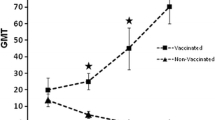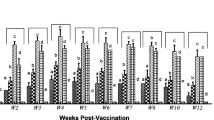Abstract
Avian influenza (AI) vaccines are widely used to control and eliminate the ongoing avian influenza virus epidemic in Egypt. A strict vaccination policy with inactivated AI vaccines has been widely applied, however the virus still circulating, evolving and causing great negative impact to the poultry sector in Egypt. Therefore, an updated poultry vaccination policy using different vaccine technologies might be valuable as an innovative additional control strategy of AIV in Egypt. In the present study, the effectiveness of different avian influenza (AI) vaccination schedules was evaluated in 300 commercial layer chicks (ISA White) using either the oil-emulsion baculovirus-H5-prototype vaccine (baculovirus-H5 prototype) or turkey herpesvirus (HVT) vector vaccine containing the hemagglutinin (HA) gene from H5N1 strain (rHVT-H5), applied alone or in combination and in different settings. Vaccination with either two injections of the baculovirus-H5 prototype, a single injection of rHVT-H5 or priming with rHVT-H5 at 1 day old followed by boosting with the baculovirus-H5 prototype induced AI-HI protective antibody responses starting as early as 3 to 4 weeks of age and lasting up to the end of the rearing period (16 weeks). A single vaccination with the baculovirus-H5 prototype did not generate a protective antibody titre for the entire rearing period. Furthermore, the present study elucidated that vaccination once or twice with the baculovirus-H5 vaccine prototype activated the chicken interferon-alpha (Ch-IFN-alpha) signalling pathway via transduction of antiviral components, e.g., Mx1 and IRF7. Birds immunized once with rHVT-H5 at 1 day old did not show activation of the Mx1 and IRF7 transcripts; however, following boosting with the baculovirus-H5 prototype vaccine, up-regulation of Mx1 and IRF7 was observed. Based on our findings, it can be concluded that either reinforcement with two injections of the baculovirus-H5 prototype or prime-boost vaccination (rHVT-H5 at 1 day old followed by the baculovirus-H5 prototype vaccine at 8 days old) is a successful strategy to induce both innate and humoral immune responses and could be recommended for the layer production sector over the entire rearing period, especially in AI-endemic areas.


Similar content being viewed by others
References
Abbas MA et al (2011) H7 avian influenza virus vaccines protect chickens against challenge with antigenically diverse isolates. Vaccine 29:7424–7429. https://doi.org/10.1016/j.vaccine.2011.07.064
Abdallah F, Hassanin O (2015) Positive regulation of humoral and innate immune responses induced by inactivated avian influenza virus vaccine in broiler chickens. Vet Res Commun 39:211–216. https://doi.org/10.1007/s11259-015-9644-3
Aly MA, Kanawaty A, Abdel-Whab Z, Hassan EM (2008) Avian influenza H7 surveillance on backyard birds around El-Abassa Lake in Egypt. Paper presented at the the Second International Conference of Virology, Emerging and Exotic Viral Infection Challenging Threats of Human, Animal and Plant Health
Arafa A, Selim A, Hassan M, Aly M (2008) Epidemiological surveillance on avian influenza virus H5N1 infection in poultry in 2007. In: 8th Scientific Conference of Egyptian Veterinary Poultry Association, Cairo, Egypt
Beato MS et al (2013) Cross-clade protection against H5N1 HPAI strains recently isolated from commercial poultry in Egypt with a single dose of a baculovirus based vaccine. Vaccine 31:5075–5081. https://doi.org/10.1016/j.vaccine.2013.08.073
Capua I, Alexander DJ (2008) Avian influenza vaccines and vaccination in birds. Vaccine 26 Suppl 4:D70–73
Capua I, Marangon S (2006) Control of avian influenza in poultry. Emerg Infect Dis 12:1319–1324. https://doi.org/10.3201/eid1209.060430
Cavalcanti O et al (2017) A genetically engineered H5 protein expressed in insect cells confers protection against different clades of H5N1 highly pathogenic avian influenza viruses in chickens. Avian Pathol J WVPA 46:224–233. https://doi.org/10.1080/03079457.2016.1250866
Gardin Y et al (2016) Experimental and field results regarding immunity induced by a recombinant Turkey herpesvirus H5 vector vaccine against H5N1 and other H5 highly pathogenic avian influenza virus challenges. Avian Dis 60:232–237. https://doi.org/10.1637/11144-050815-ResNote
Haller O, Stertz S, Kochs G (2007) The Mx GTPase family of interferon-induced antiviral proteins. Microbes Infect 9:1636–1643. https://doi.org/10.1016/j.micinf.2007.09.010
Ikegami T, Narayanan K, Won S, Kamitani W, Peters CJ, Makino S (2009) Dual functions of rift valley fever virus NSs protein: inhibition of host mRNA transcription and post-transcriptional downregulation of protein kinase PKR. Ann N Y Acad Sci 1171 Suppl 1:E75-85 https://doi.org/10.1111/j.1749-6632.2009.05054.x
Jiang H, Yang H, Kapczynski DR (2011) Chicken interferon alpha pretreatment reduces virus replication of pandemic H1N1 and H5N9 avian influenza viruses in lung cell cultures from different avian species. Virol J 8:447. https://doi.org/10.1186/1743-422x-8-447
Kapczynski DR, Esaki M, Dorsey KM, Jiang H, Jackwood M, Moraes M, Gardin Y (2015) Vaccine protection of chickens against antigenically diverse H5 highly pathogenic avian influenza isolates with a live HVT vector vaccine expressing the influenza hemagglutinin gene derived from a clade 2.2 avian influenza virus. Vaccine 33:1197–1205. https://doi.org/10.1016/j.vaccine.2014.12.028
Kayali G, Webby RJ, Xiong X, Sherif LS, El-Ghafar EA, Ali MA (2010) Prospective study of avian influenza transmission to humans in Egypt. BMC Public Health 10:685. https://doi.org/10.1186/1471-2458-10-685
Kayali G et al (2014) Active surveillance for avian influenza virus, Egypt, 2010–2012. Emerg Infect Dis 20:542–551. https://doi.org/10.3201/eid2004.131295
Kilany W et al (2014) Protection conferred by recombinant turkey herpesvirus avian influenza (rHVT-H5) vaccine in the rearing period in two commercial layer chicken breeds in Egypt. Avian Pathol J WVPA 43:514–523. https://doi.org/10.1080/03079457.2014.966302
Kilany WH et al (2015) Comparison of the effectiveness of rHVT-H5, inactivated H5 and rHVT-H5 with inactivated H5 prime/boost vaccination regimes in commercial broiler chickens carrying MDAs against HPAI H5N1 clade 2.2.1 virus. Avian Pathol J WVPA 44:333–341. https://doi.org/10.1080/03079457.2015.1053840
Kim JK et al (2008) Pathogenicity and vaccine efficacy of different clades of Asian H5N1 avian influenza A viruses in domestic ducks. J Virol 82:11374–11382. https://doi.org/10.1128/jvi.01176-08
Li XY, Qu LJ, Yao JF (2006) Skewed allele frequencies of an Mx gene mutation with potential resistance to avian influenza virus in different chicken populations. Poult Sci 85:1327–1329
Marangon S, Cecchinato M, Capua I (2008) Use of vaccination in avian influenza control and eradication. Zoonoses Public Health 55:65–72. https://doi.org/10.1111/j.1863-2378.2007.01086.x
OIE (2011) Current evolution of avian influenza H5N1 viruses
OIE (2015) Avian influenza (Infection with Avian Influenza Viruses). Capter 2.3.4
Ono C et al (2014) Innate immune response induced by baculovirus attenuates transgene expression in mammalian cells. J Virol 88:2157–2167. https://doi.org/10.1128/jvi.03055-13
Park EH et al. (2014) Protective efficacy of a single dose of baculovirus hemagglutinin-based vaccine in chickens and ducks against homologous and heterologous H5N1 virus infections. Viral Immunol. 27:449–462 https://doi.org/10.1089/vim.2014.0029
Rauw F, Palya V, Gardin Y, Tatar-Kis T, Dorsey KM, Lambrecht B, van den Berg T (2012) Efficacy of rHVT-AI vector vaccine in broilers with passive immunity against challenge with two antigenically divergent Egyptian clade 2.2.1 HPAI H5N1 strains. Avian Dis 56:913–922 https://doi.org/10.1637/10172-041012-Reg.1
Richter MF, Schwemmle M, Herrmann C, Wittinghofer A, Staeheli P (1995) Interferon-induced MxA protein. GTP binding and GTP hydrolysis properties. J Biol Chem 270:13512–13517
Sims LD (2007) Lessons learned from Asian H5N1 outbreak control. Avian Dis 51:174–181 https://doi.org/10.1637/7637-042806r.1
Swayne DE (2003) Vaccines for list a poultry diseases: emphasis on avian influenza. Dev Biol 114:201–212
Swayne DE (2012) The role of vaccines and vaccination in high pathogenicity avian influenza control and eradication. Expert Rev Vaccines 11:877–880. https://doi.org/10.1586/erv.12.60
Swayne DE, Suarez DL (2000) Highly pathogenic avian influenza revue scientifique et technique. (Int Off Epizootics) 19:463–482
Swayne DE, Beck JR, Perdue ML, Beard CW (2001) Efficacy of vaccines in chickens against highly pathogenic Hong Kong H5N1 avian influenza. Avian Dis 45:355–365
Swayne DE, Lee CW, Spackman E (2006) Inactivated North American and European H5N2 avian influenza virus vaccines protect chickens from Asian H5N1 high pathogenicity avian influenza virus. Avian Pathol J WVPA 35:141–146. https://doi.org/10.1080/03079450600597956
Terregino C et al (2010) Evaluation of the protection induced by avian influenza vaccines containing a 1994 Mexican H5N2 LPAI seed strain against a 2008 Egyptian H5N1 HPAI virus belonging to clade 2.2.1 by means of serological and in vivo tests. Avian Pathol J WVPA 39:215–222. https://doi.org/10.1080/03079451003781858
Author information
Authors and Affiliations
Corresponding authors
Ethics declarations
Conflict of interest
The authors whose names are listed have no affiliations with or involvement in any organization or entity with any financial interest or non-financial interest in the subject matter or materials discussed in this manuscript.
Rights and permissions
About this article
Cite this article
Hamad, M., Amen, O., Mahmoud, M. et al. Effectiveness of different avian influenza (H5) vaccination regimens in layer chickens on the humoral immune response and interferon-alpha signalling immune marker. Vet Res Commun 42, 145–152 (2018). https://doi.org/10.1007/s11259-018-9717-1
Received:
Accepted:
Published:
Issue Date:
DOI: https://doi.org/10.1007/s11259-018-9717-1




